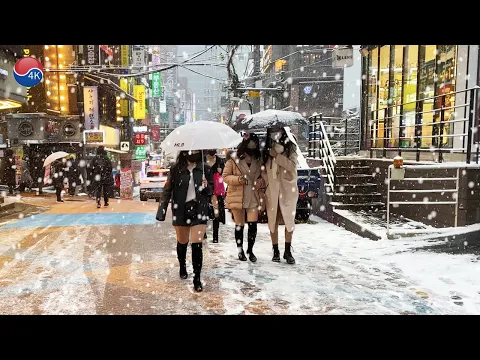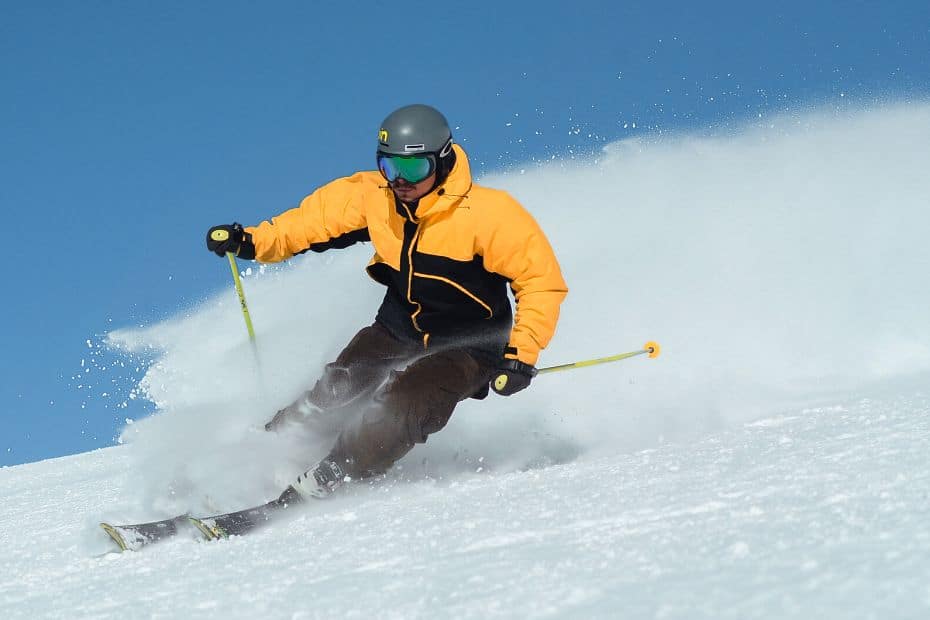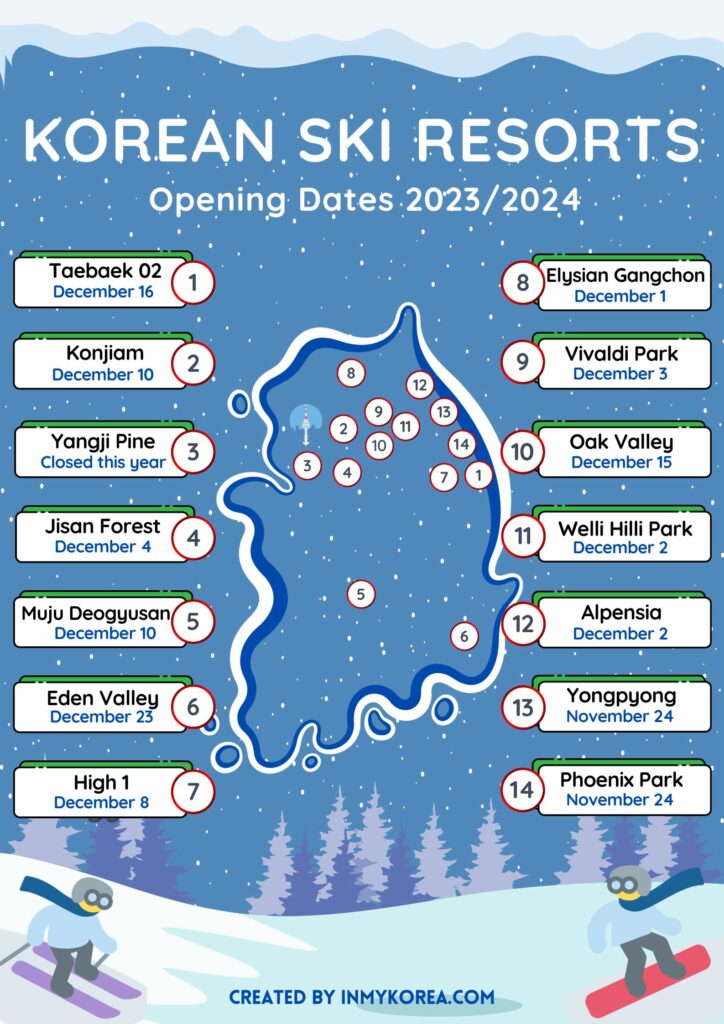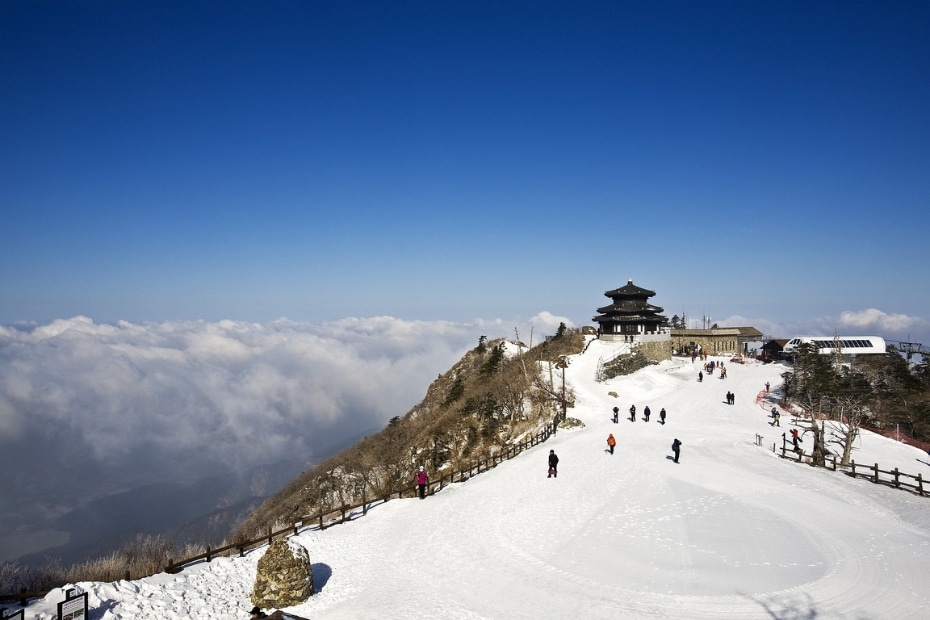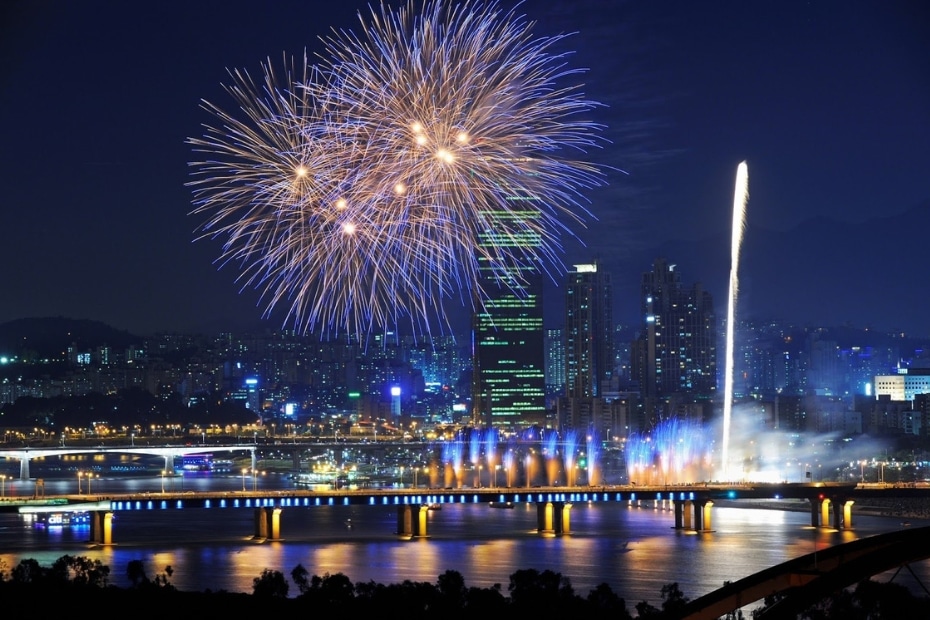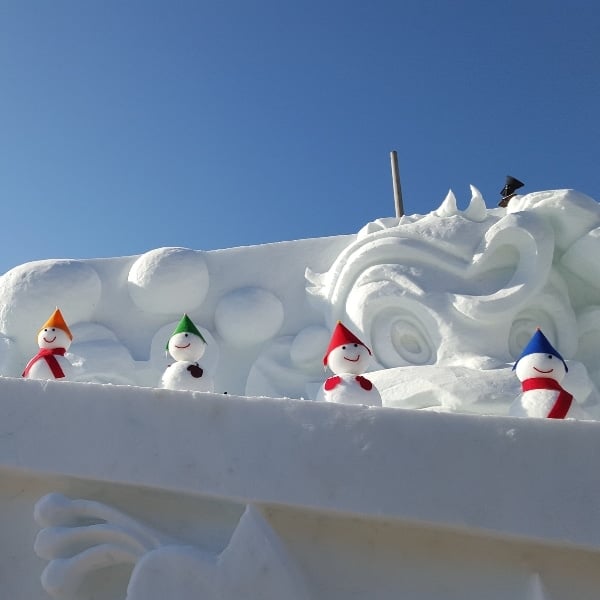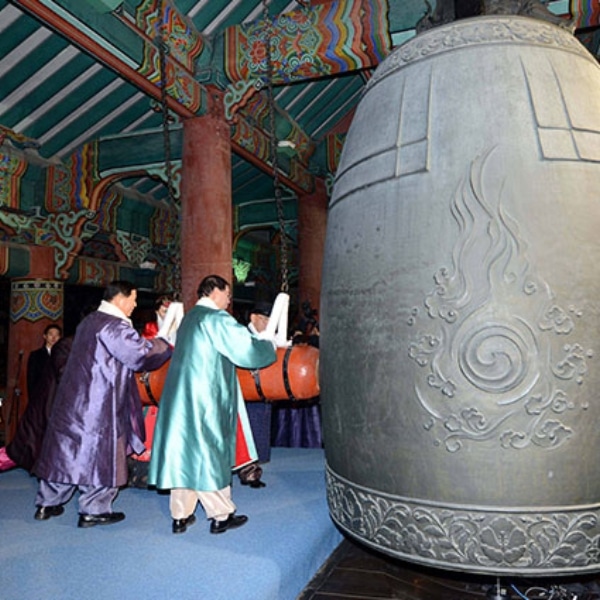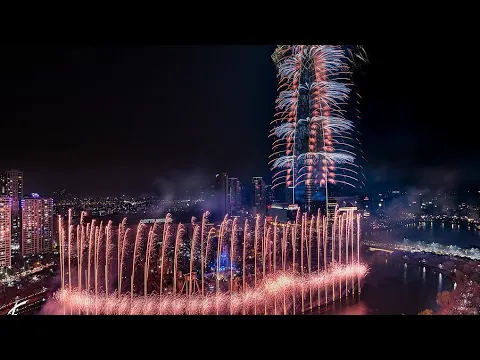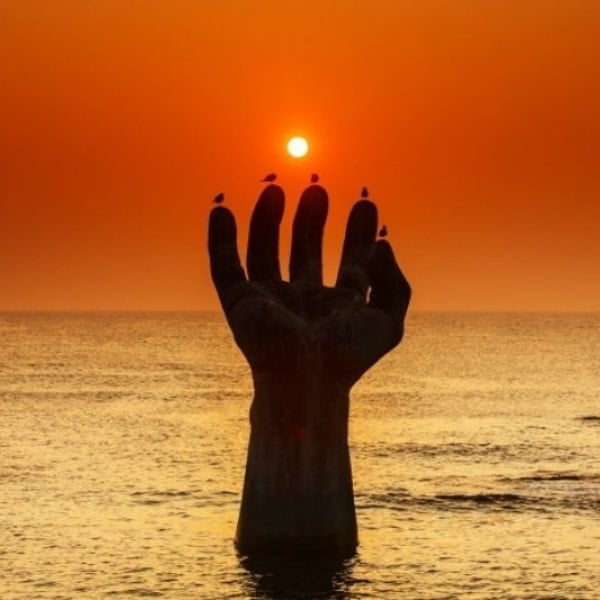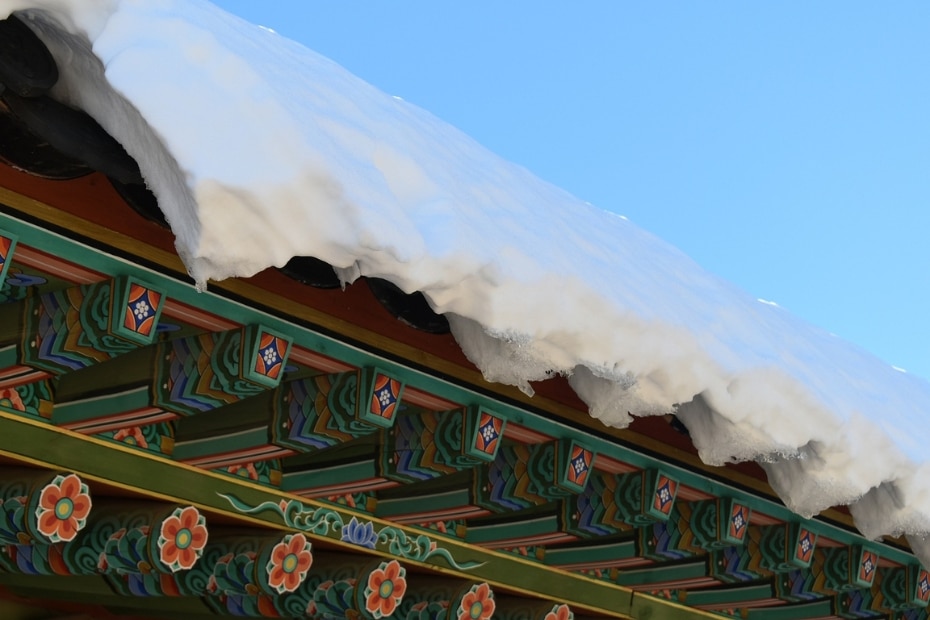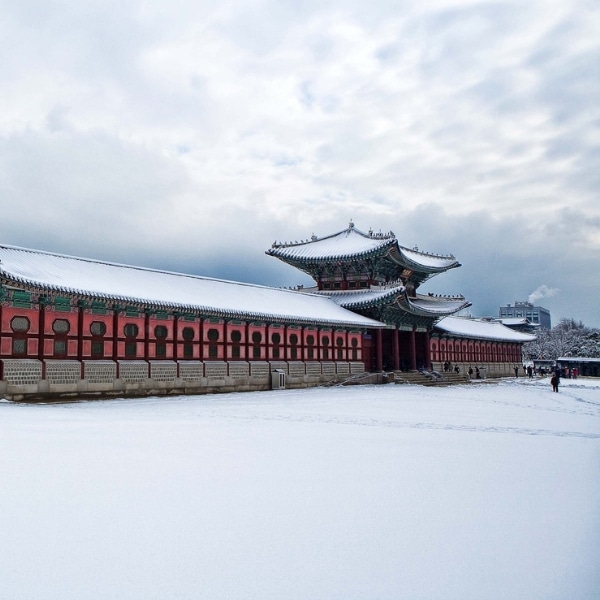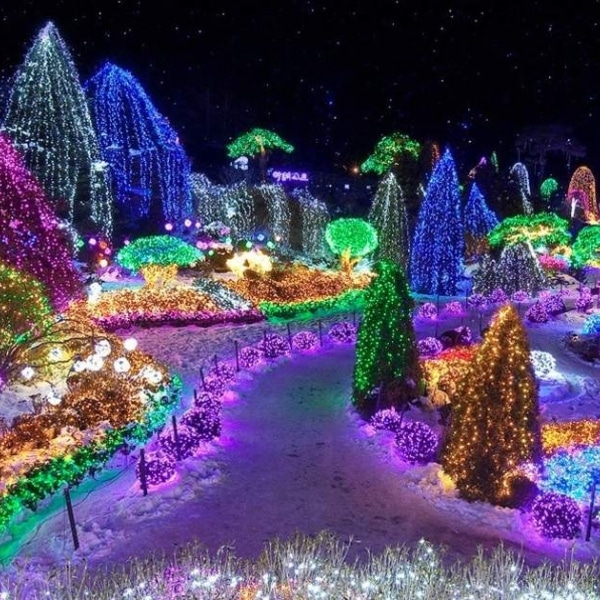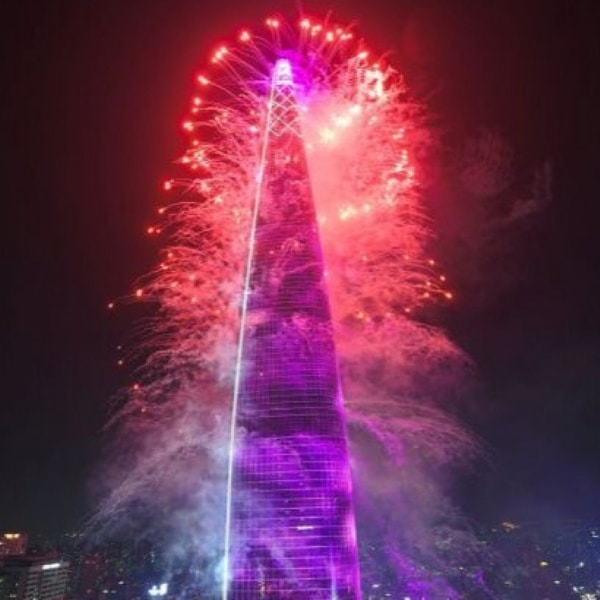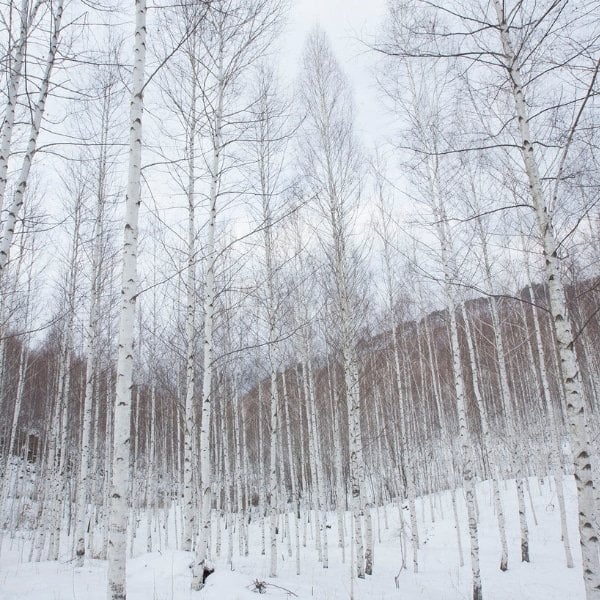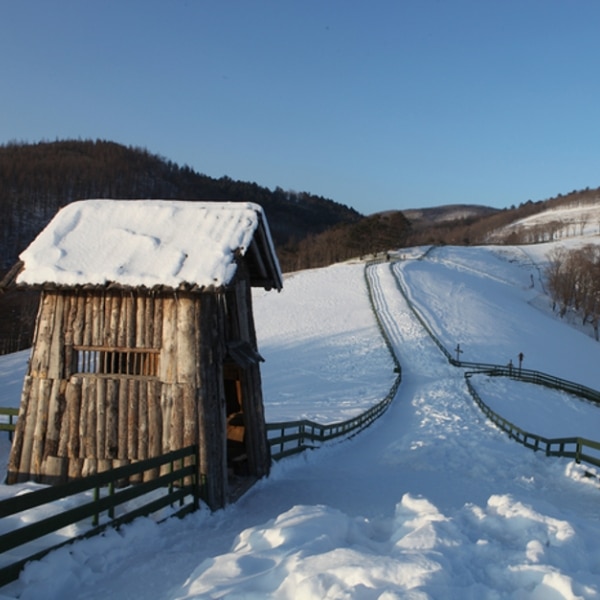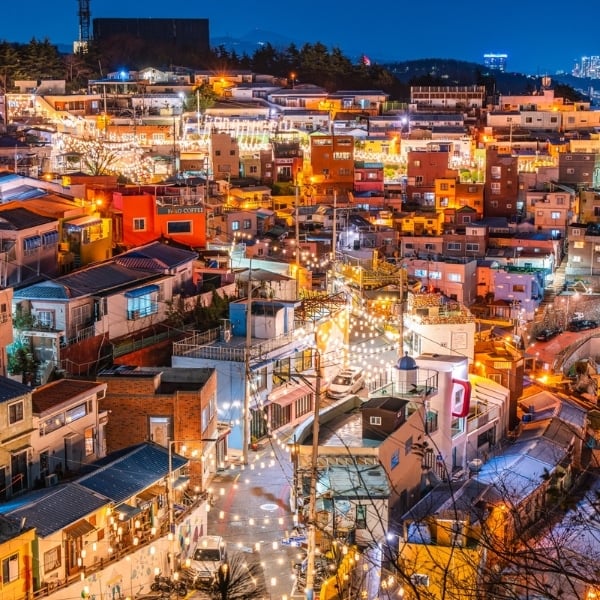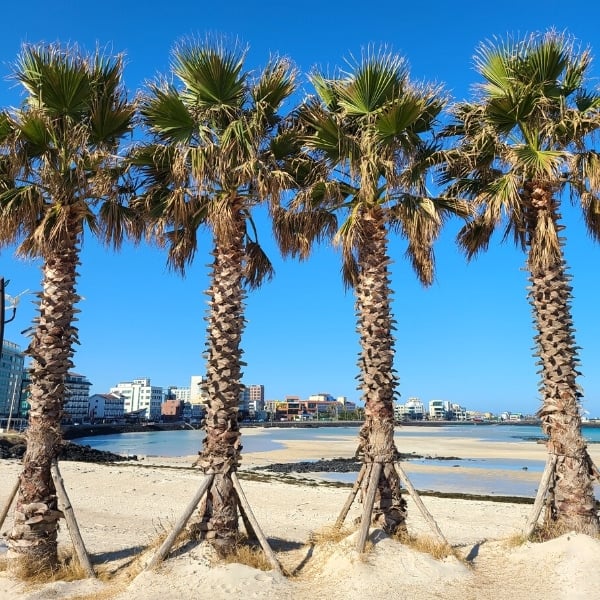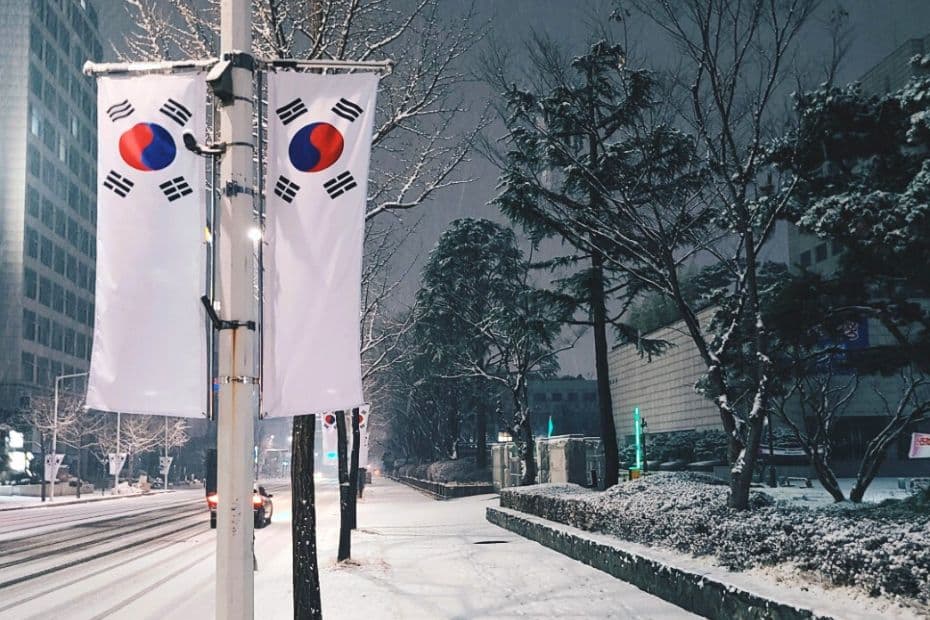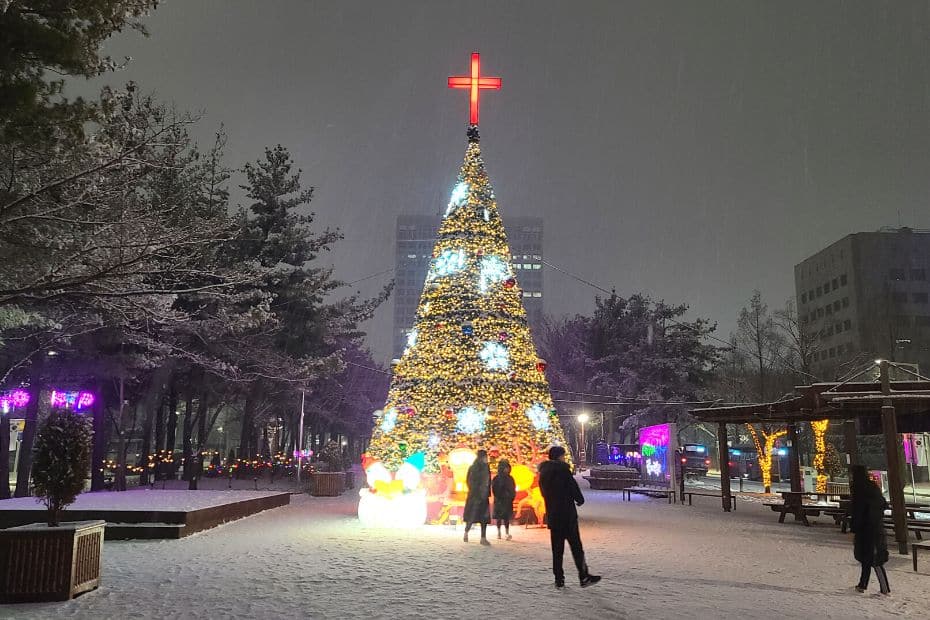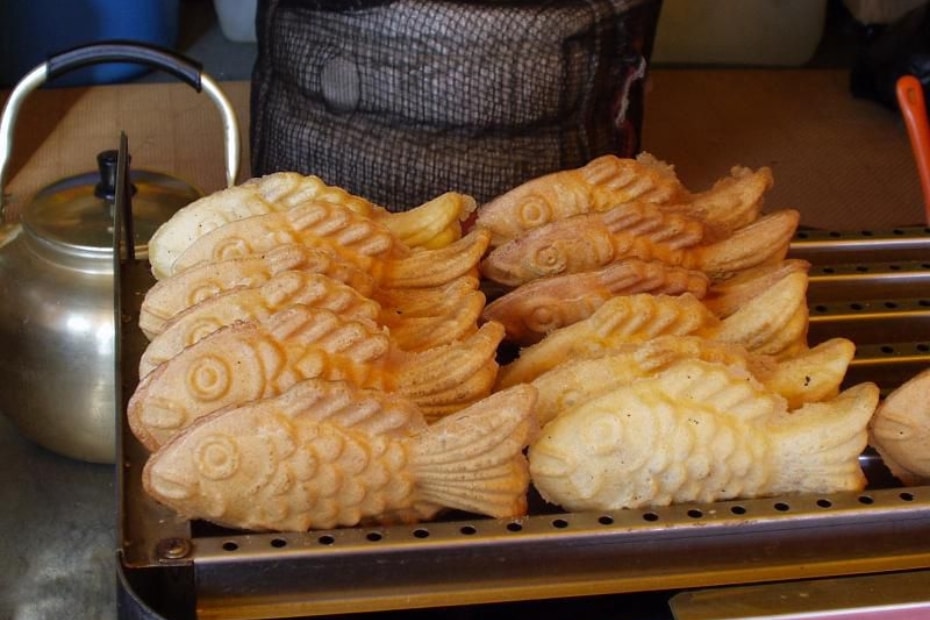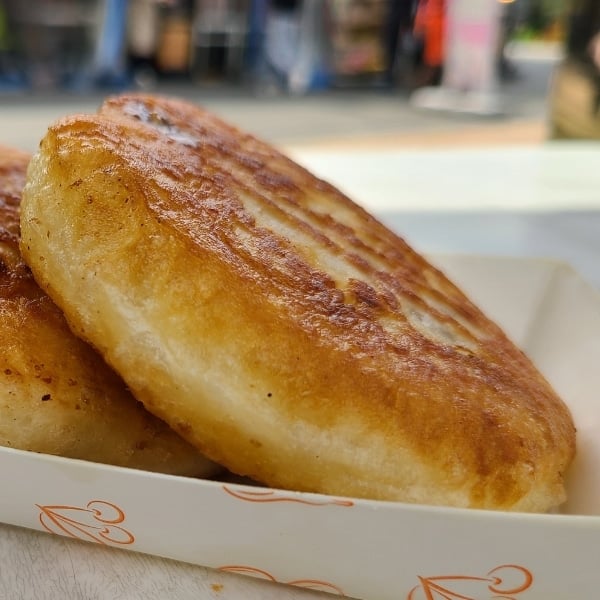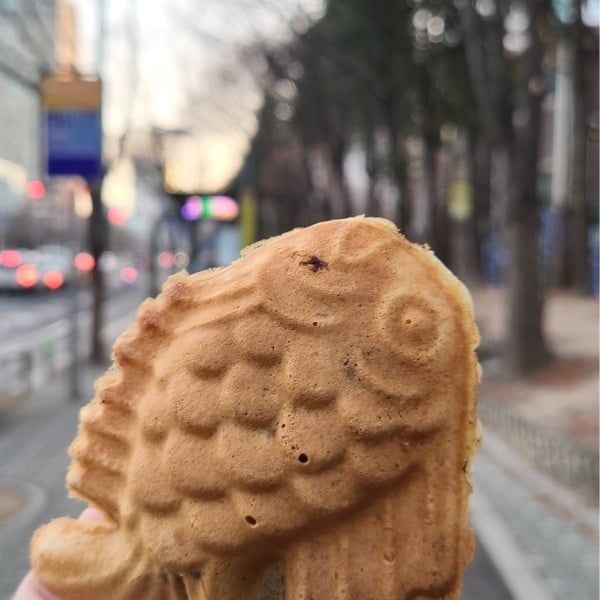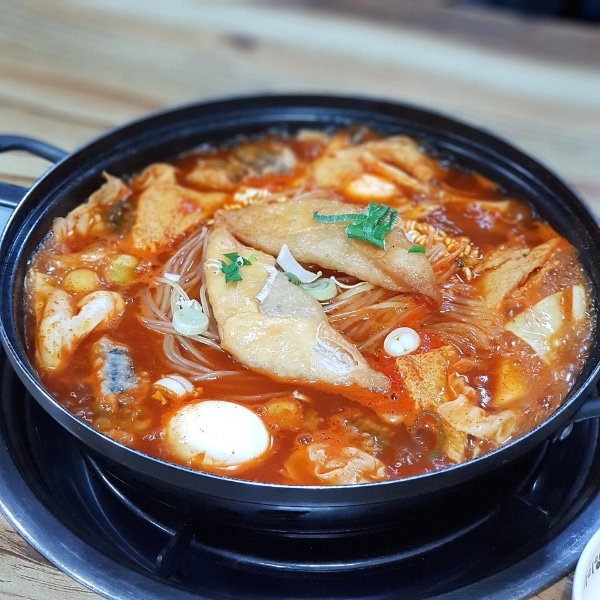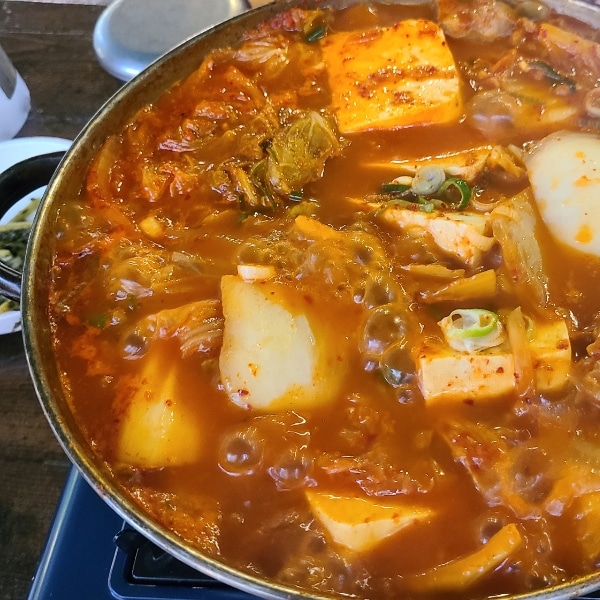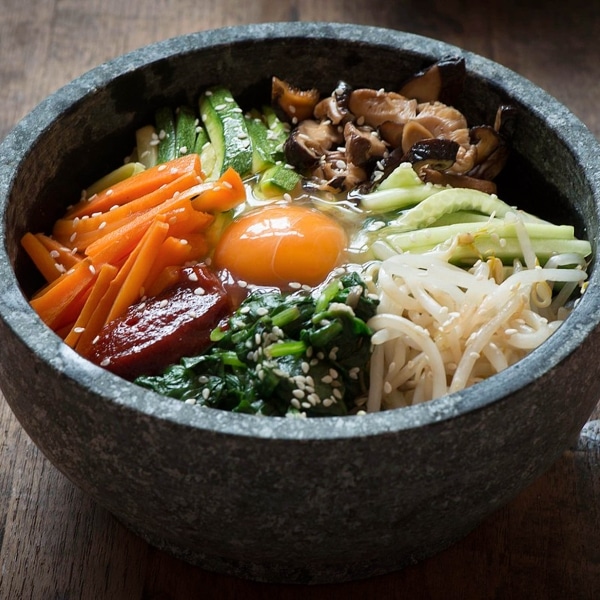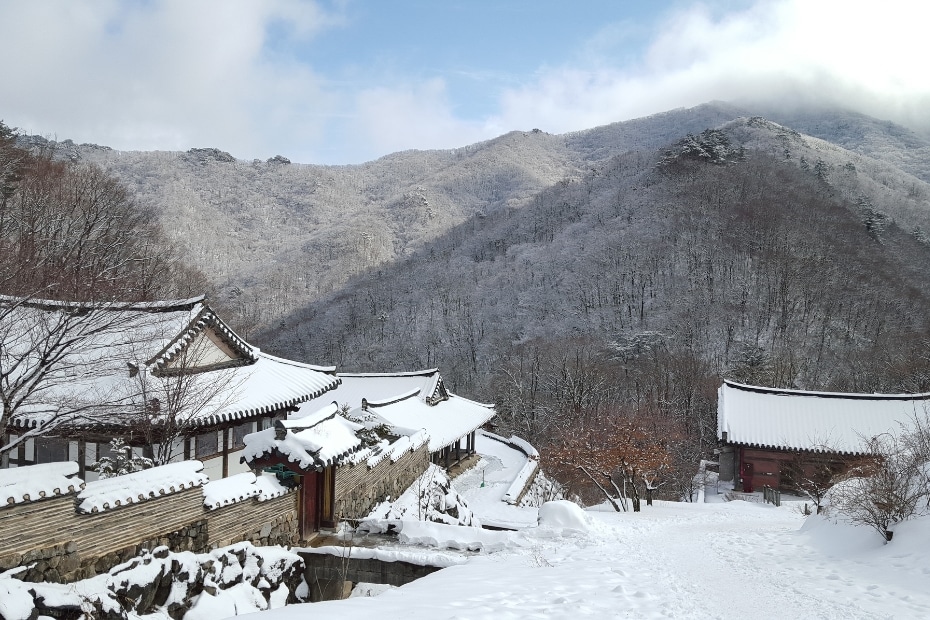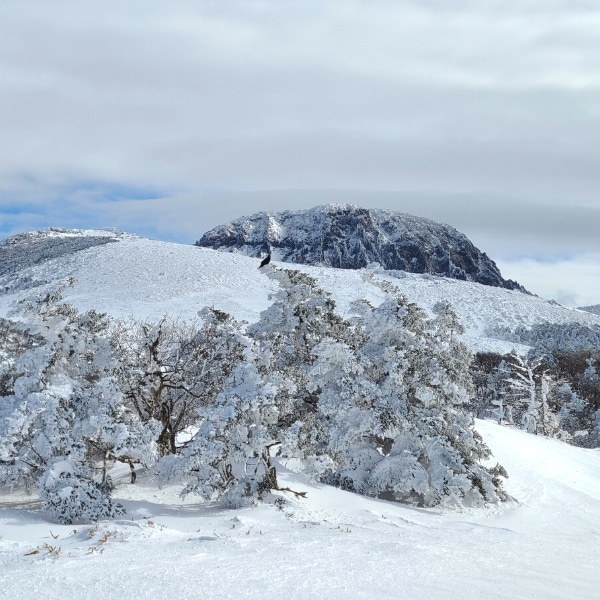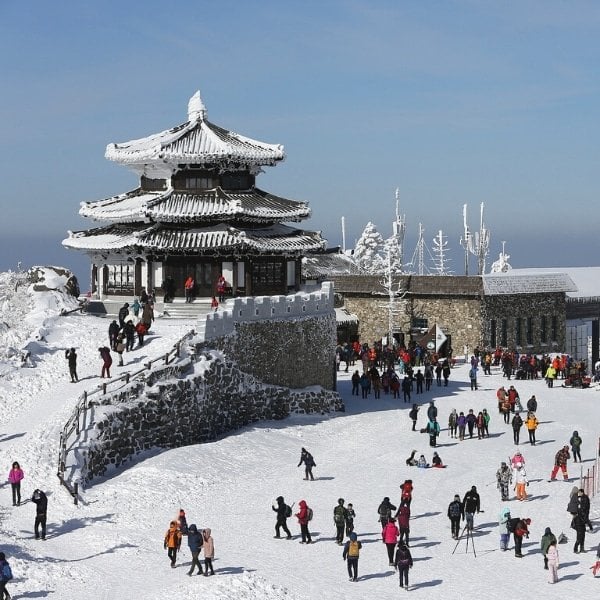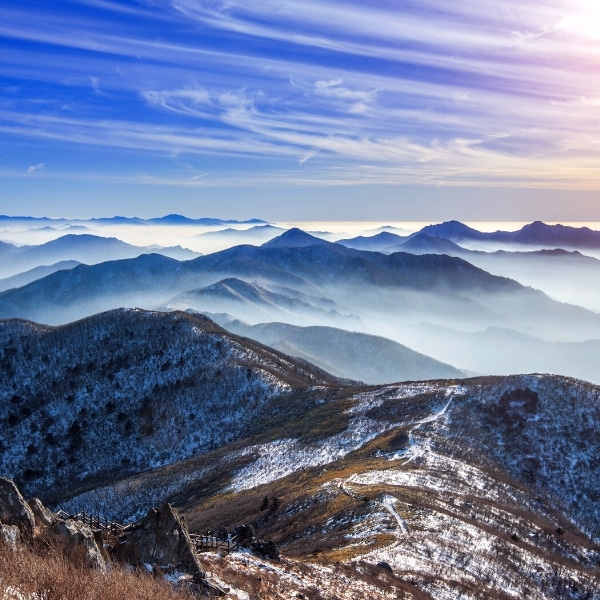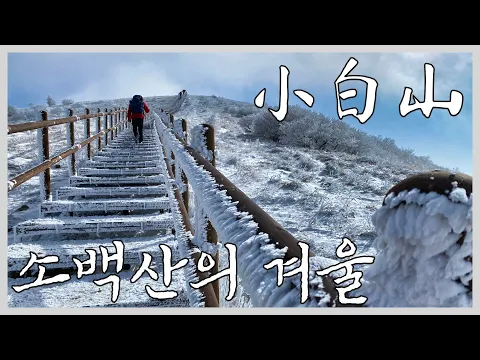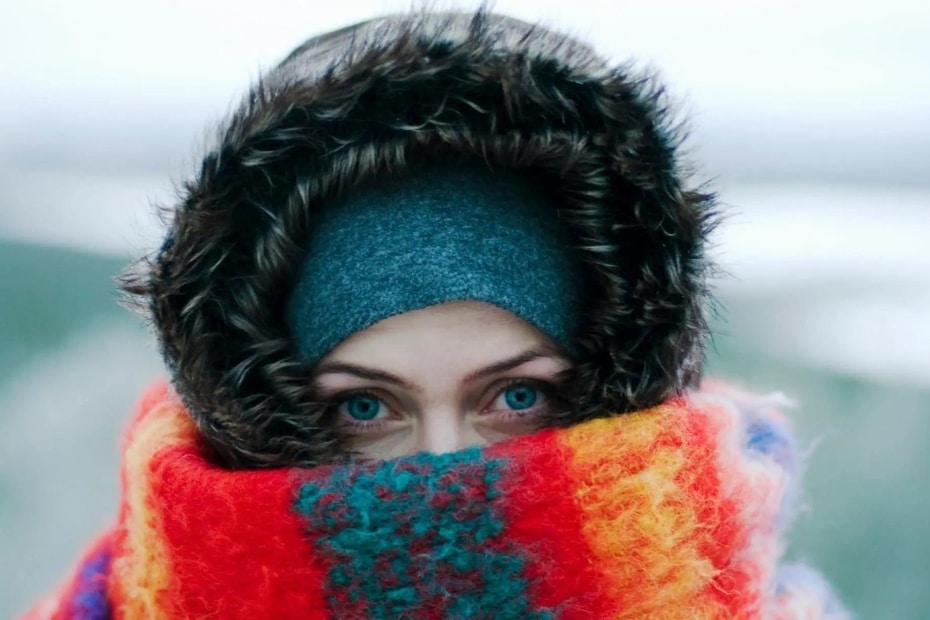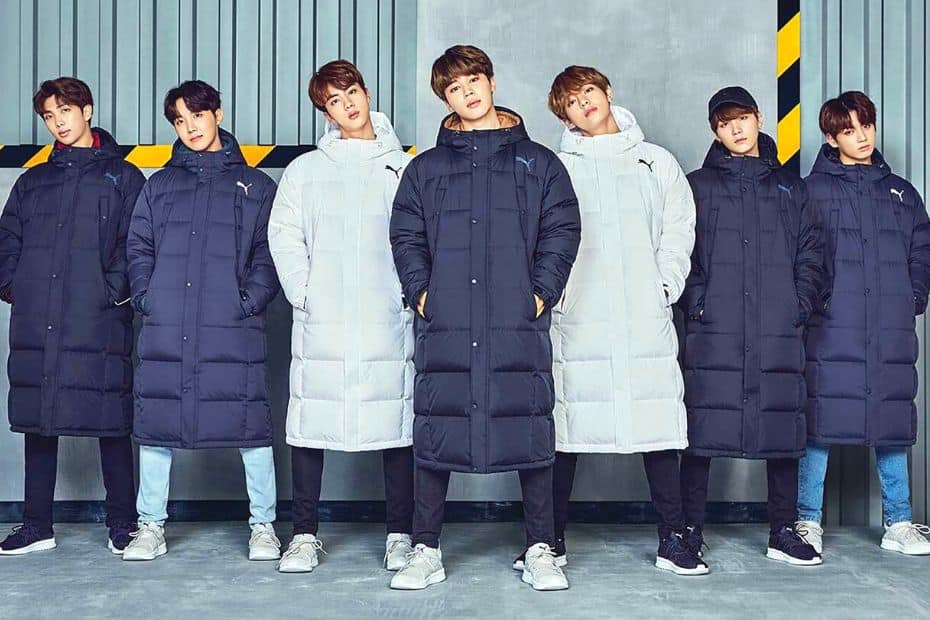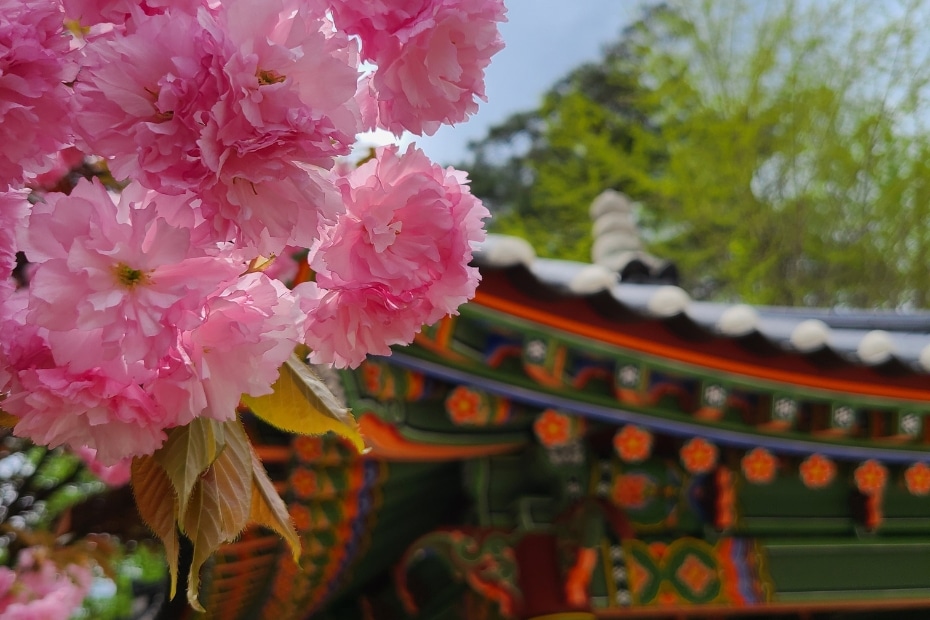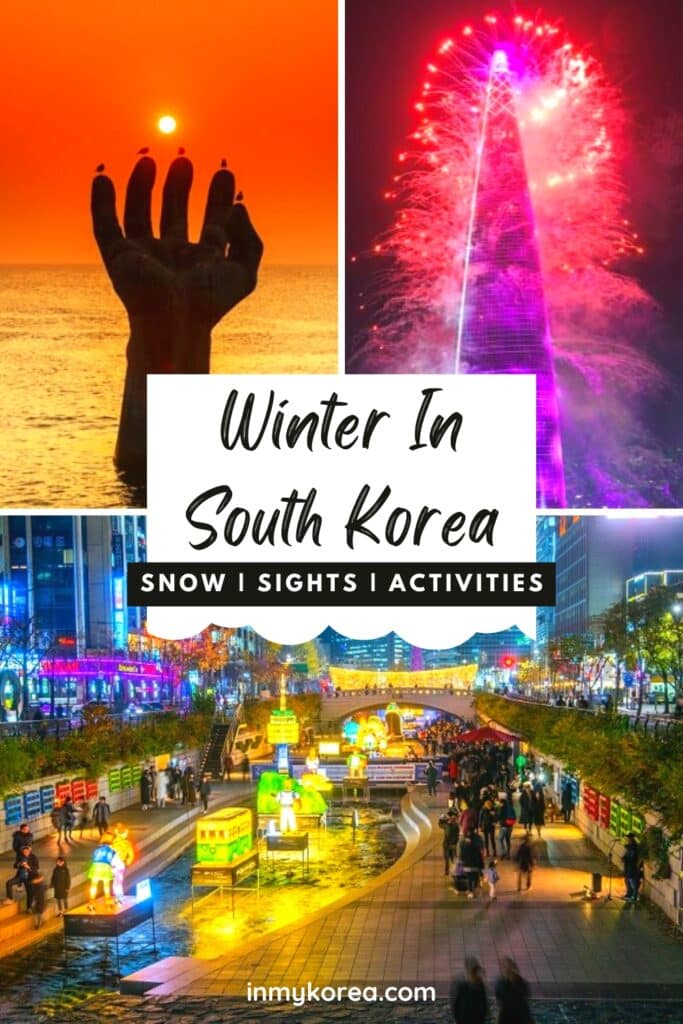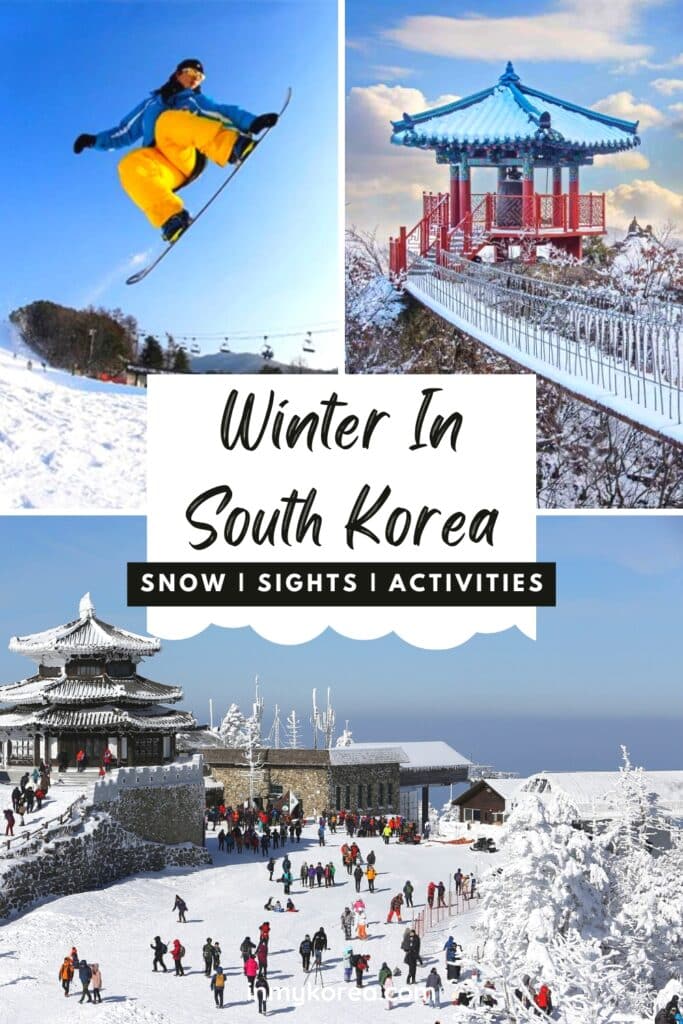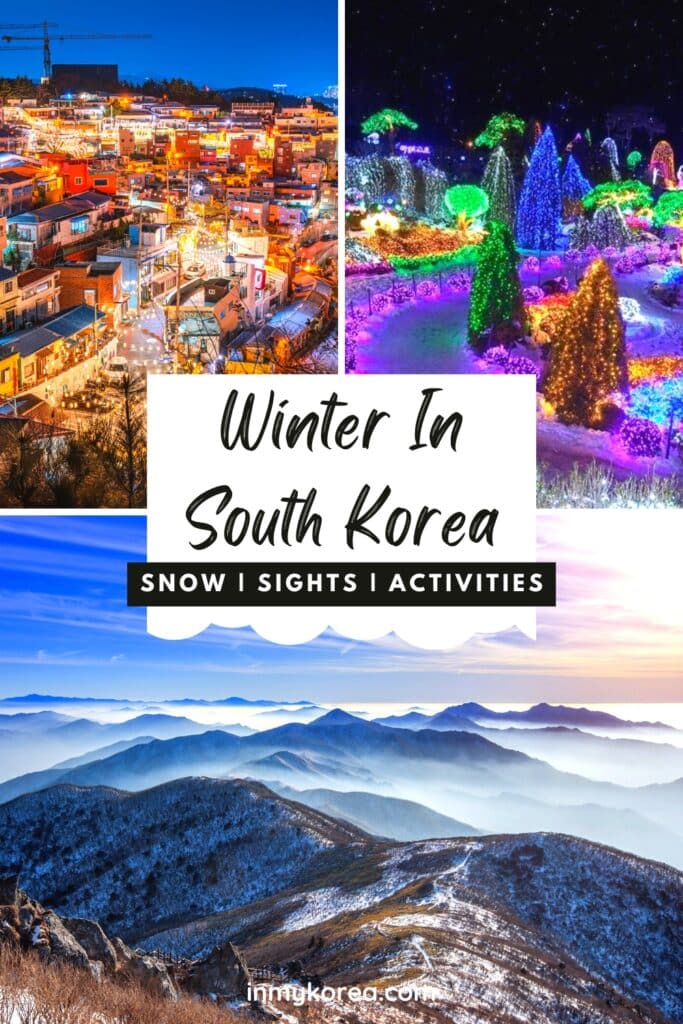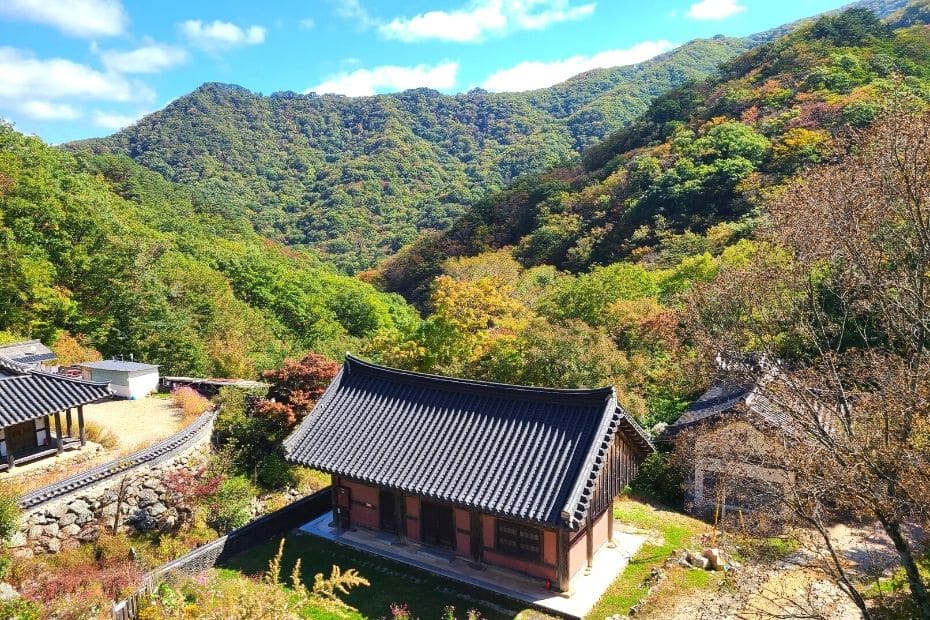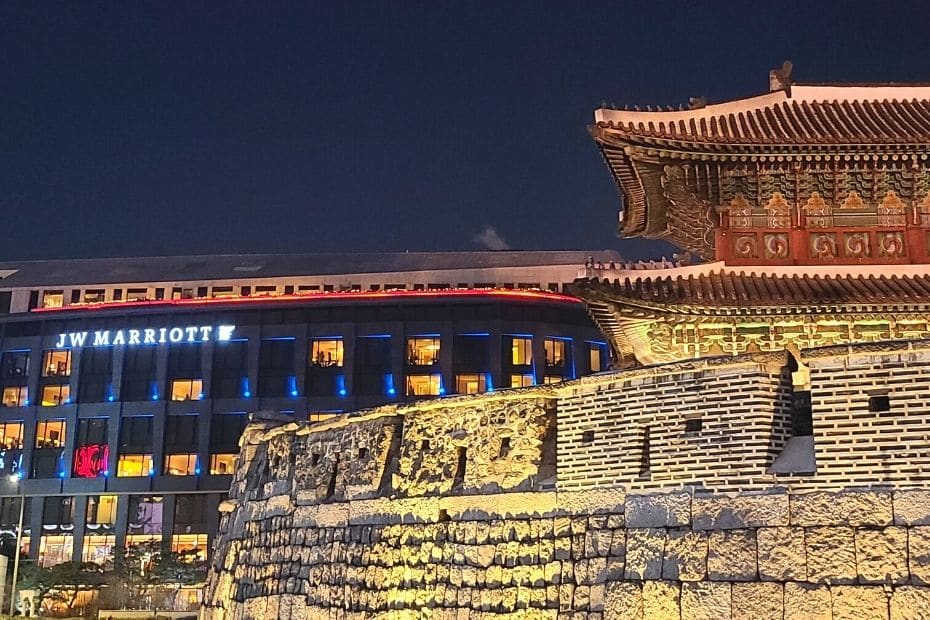Want to know the best things to do in winter in Korea? What winter activities you can try in Korea and what winter festivals are on? Where you should visit in winter in Korea and what winter food you should try? Check out this essential guide to visiting Korea during winter to find out all you need to know about visiting South Korea when it’s cold and snowy.
Discover all of the best things to see, do, eat, and enjoy during winter in Korea this year. Try out ice fishing from a frozen river. Play in the snow, go hiking, or do winter sports in Korea’s many mountains. Then sit back and relax with a bowl of hot, spicy Korean winter food.
This article will provide you with lots of essential information about what to wear and pack for your trip to Korea, special holidays during winter in Korea, and tips to help you get the most out of this cold season. Start planning your snowy winter trip to Korea right now.
Affiliate Disclaimer: This site contains affiliate links and I may earn commission for purchases made after clicking these links.
What’s In This Winter in Korea Guide
There are many awesome things to do in Korea during winter, which means that this is quite a long article. To make it easier to find what you’re interested in, click the links below to jump straight to that section, or read on to discover all the amazing things that winter in Korea has to offer you.
Planning to visit Korea? These travel essentials will help you plan your trip, get the best deals, and save you time and money before and during your Korean adventure.
Visas & K-ETA: Some travellers to Korea need a Tourist Visa, but most can travel with a Korean Electronic Travel Authorisation (K-ETA). Currently 22 Countries don’t need either one.
How To Stay Connected: Pre-order a Korean Sim Card or a WiFi Router to collect on-arrival at Incheon Airport (desks open 24-hours). Alternatively, download a Korean eSIM for you travels.
Where To Stay: For Seoul, I recommend Myeongdong (convenient), Hongdae (cool culture) or Gangnam (shopping). For Busan, Haeundae (Beach) or Seomyeon (Downtown).
Incheon Airport To Seoul: Take the Airport Express (AREX) to Seoul Station or a Limo Bus across Seoul. Book an Incheon Airport Private Transfer and relax to or from the airport.
Korean Tour Operators: Tour companies that have a big presence in Korea include Klook, Trazy, Viator, and Get Your Guide. These sites offer discounted entry tickets for top attractions
Seoul City Passes: Visit Seoul’s top attractions for free with a Discover Seoul Pass or Go City Seoul Pass. These passes are great for families and couples visiting Seoul – you can save lots.
How To Get Around: For public transport, grab a T-Money Card. Save money on Korea’s high speed trains with a Korea Rail Pass. To see more of Korea, there are many Rental Car Options.
Travel Money: Use money exchanges near Myeongdong and Hongdae subway stations for the best exchange rates. Order a Wise Card or WOWPASS to pay by card across Korea.
Flights To Korea: I use flight comparison sites such as Expedia and Skyscanner to find the best flights to Korea from any country. Air Asia is a good option for budget flights from Asia.
How To Learn Korean: The language course from 90 Day Korean or Korean Class 101 both have well-structured lessons and lots of useful resources to help you learn Korean.
Winter Activities In Korea
Not sure what to during winter in Korea? Want to know what Korean winter activities you can try when you travel? Here are some of my favourite winter activities to experience in Korea that will give you a memorable journey, show you snowy sights, and keep you warm during the cold days.
You can experience several of these activities in one day. One idea for you is to start a wintry theme park, seeing snowy sights and ice sculptures, then go skating on ice before heading indoors to soak in a steamy sauna. That’s certainly how I love to spend the cold days in winter when it’s freezing.
Visit A Wintry Theme Park
Korea’s theme parks are fun places to visit during winter as they hold winter or Christmas-themed parades, events and activities for the whole family to enjoy. Take in the festive sights and winter activities at each one, such as winter sledding, snowball fights, and illuminations.
Here are some of the best theme parks to check out for wintry fun when you visit Korea:
Warm Up At A Korean Sauna
There’s nothing better on a winter’s day in Korea than sitting in a hot, steaming pool or sauna, letting the warmth return to your bones. Korean saunas, known as jjimjilbang in Korean, are very popular in winter to escape the cold.
There are 2 places in a Korean sauna. The first is the bathing area, where you sit naked with people of the same gender. The second is a communal room where everyone can meet wearing pyjamas, relax, and sleep.
Want to visit an outdoor hot spring in Korea? Visit Onyang Hot Springs in Asan City, the oldest hot springs in Korea, used by locals for over 600 years to take away the winter chills. Prefer luxurious pampering in Seoul? Try the O Hui and Whoo Spa for an indulgent spa care package.
Try Ice Skating In Seoul
Ice skating is a popular Korean winter activity and there are ice skating facilities in major cities across Korea, such as in Seoul, Busan, Incheon, and Daejeon. Ice skating rinks appear in December and stay open until February.
You can find ice skating rinks both indoors and outdoors. The outdoor rinks, such as the one outside Seoul City Hall (Seoul Plaza Ice Rink), is a great place to try skating or to watch others sliding around on a sunny winter’s day. I love visiting ice rinks for the atmosphere and to experience a ride on the ice.
Want to try ice skating in Korea? The good news is you don’t need to worry about bringing your own equipment, you can rent it all at the skate rink. Here are some of the best ice skating rinks in Korea. These places are suitable for families and first time skaters.
- Mokdong Ice Rink in Seoul
- Lotte World Ice Rink in Seoul
- Grand Hyatt Ice Rink in Seoul
- Yeouido Hangang Park Ice Skating Rink in Seoul
- Seonhak International Ice Rink in Incheon
- Shinsegae Centum City Rink in Busan
- Daejeon Expo Plaza in Daejeon
Han River Park Sledding
After 3 years of absence, the sledding slopes have returned to Seoul and the Han River at Ttukseom Hangang Park. This is a family-friendly winter activity in Korea that everyone can enjoy. Grab a sled or rubber tube and zoom down the icy slope towards the river.
There is also a winter sledding park at Jamwon Hangang Park. As well as regular slopes, this park has slopes for younger fun-lovers and is designed for children under the age of 6. Perfect for introducing your children to winter sports. If you’re visiting Korea with children, definitely check out one of Seoul’s sledding parks.
Sample Korean Strawberries
Winter in Korea is when some of the best fresh fruit is available, including Jeju Island’s hallabong oranges and sweet strawberries. These juicy fruits grow in Korea from mid-December until early March and you’ll find them for sale in markets and shops. There are also a few places in Seoul that offer strawberry buffets with unlimited strawberry-based desserts and treats.
Want to pick strawberries in Korea? A more fun options it to pick your own strawberries at a strawberry farm in Korea. Why not book a day tour that includes strawberry picking as an extra to visiting another site? Visit Pocheon Art Valley in winter to harvest fresh strawberries from the wide fruit fields or this winter-only tour that includes the Garden of Morning Calm, too.
Experience Korean Coffee Culture
Korea, like me, is addicted to coffee. There are more than 75,000 coffee shops in the country and over 18,000 in Seoul alone. Winter is a great time to visit Seoul’s hot cafes, found in quiet back streets or in popular hanok villages, such as Bukchon Hanok Village.
If you want to experience Korean coffee culture outside of Seoul, be sure to visit Gangneung on the east coast, home to the Gangneung Coffee Street and Gangneung Coffee Festival. Enjoy a hot coffee, watch the waves, and stay out of the cold. Jeju Island also has great cafes which are perfect for cold-weather cafe hopping.
Besides coffee culture, you can also enjoy traditional Korean tea culture in Seoul and other places. Korean tea houses feature wooden floors and furniture, delicate and healthy teas, and a serene atmosphere to contemplate what Korean winter activities to enjoy next.
Take A Walk In The Snow
A free activity that everyone can enjoy during winter in Korea is a walk in the streets when snow falls. Korea’s cities can be drab during the day, but come alive with neon lights at night. During snowy days, which are more dark than light, seeing snow-covered streets and shining lights is a real treat.
You should definitely take a walk around Seoul and other historic cities, such as Gyeongju or Andong. Winter walks are especially rewarding as you can see fortress walls, palace grounds, hanok houses, and curved rooftops covered in snow when it’s cold enough.
Want to explore Seoul on foot? Check out these city walking trails in Seoul that you can enjoy in winter or any other time of year, all for free. It’s really the best way to see a city and get some exercise.
Here are some videos showing what Seoul looks like when it snows.
Ski Resorts And Winter Sports 2024
Fans of winter sports, or those who want to learn, will find plenty of places to ski and snowboard in Korea’s many mountains. The majority of Korea’s ski resorts are located between Seoul and the east coast in Gyeongi and Gangwon Provinces.
This is one of the most popular winter activities in Korea, so expect ski resorts to be busy on weekends. The weekdays can be quieter and provide a better ski or snowboard experience.
Ski Resorts In Korea 2024
There are 14 major ski resorts in Korea that open between December and February or March each year. The opening times of these ski resorts vary depending on their location, the onset of winter, and their elevation. The start of ski season in Korea is December and the end is February.
The first ski resorts in Korea open in early December and can be found in the northern part of Korea and around Seoul. The last ski resort to open for the season is Eden Valley, which is much further south, close to Busan. This opens around mid to late December each year.
The full list of opening dates for Korean ski resorts this winter can be seen below.
There are several family-friendly ski resorts in Korea that provide not only good ski facilities, they also have a range of other winter activities for the whole family to enjoy. The best ski resorts for families are Jisan Forest, Elysian Gangchon, Yongpyong, and Vivaldi Park.
Ski Resort Tours & Packages
Driving is the most convenient way to get to Korea’s ski resorts. If you rent a car in Korea, you can drive to the ski resorts in an hour or two from Seoul. Some ski resorts can also be accessed by a shuttle or tour bus from Seoul or nearby towns. Only drive if you’re comfortable driving in snow though.
One of the easiest ways to get to a Korean ski resort without public transport or hired car, is to book a ski-resort tour. There are many tour options available, from one-day trips to ski or play in the snow, to multi-day trips that include accommodation and equipment rental. I’ve added tours for you below.
An overnight stay is a good option for those who want to experience a sunrise in the snowy peaks and typically comes with all the necessary parts of the trip included, such as transportation, ski rentals, and accommodation. If you’ve never seen a mountain sunrise, I highly recommend it!
Here are some of the best ski resorts in Korea for winter snow sports and tour options for each. As these are located high up in the snowy mountains, with limited public access, tours are generally the best option to get to ski resorts, which is why I’ve added a couple of options for each location.
High 1 Ski Resort: This massive ski resort is one of the most exciting places to ski in Korea and comes with world-class skiing facilities. High 1 features 18 ski slopes covering 21km of snow-filled mountain paths that are suitable for any level, from beginners to experts.
Vivaldi Park Ski Resort: The most popular ski resort in Korea, with state of the art facilities and amazing courses. There are 12 slopes and 10 lifts here, with something suitable for any level, as well as Snowy Land – a family-fun play area to mess around in the snow.
Jisan Forest Ski Resort: Feauturing a range of slopes from beginner to advancd, Jisan Forest is a compact ski resort nestled in forested slopes that also has a snow sleigh park to play in and teaching area for people interested in learning to ski for the first time.
Alpensia Ski Resort: One of the main resorts used for the 2018 Winter Olympics, Alpensia Ski Resort offers a range of winter activities for levels of all ages. There are 6 courses for various skill levels.
Elysian Gangchon Ski Resort: The lovely Elysian Gangchon Resort offers skiing, snowboard, and snow sledding. You can also hike around the area and see the beautiful snow-covered Korean nature.
Yongpyong Ski Resort: Another resort used for the 2018 Winter Olympics. This is a large ski resort that has 28 slopes to choose from. Very popular with ski and snowboarding enthusiasts.
Eden Valley: Looking to ski close to Busan? This ski resort on the slopes of Sinbulsan Mountain has 7 slopes for different levels and has a ski school for those looking to learn to ski or board.
There are plenty of ski tours and day trips to ski resorts available. If you want to check out a different ski resort or package, these companies have a wide range of ski tours for you.
Winter Festivals In Korea 2024
I love travelling in Korea as it’s a country that has many wonderful festivals throughout the year, and winter is certainly no exception. Discover sparkling illuminations and glowing lanterns, see icy sculptures and snowy landscapes, and try your hand at winter activities in Korea such as ice fishing, sledding, listening to temple bells ringing on New Year’s Eve, and watching the first sunrise of the year.
Here are some of the different types of winter festivals you can experience in Korea, as well as some of the best of each type. For a more detailed list of what’s on, check out my guide to the best Korean winter festivals, which include lots more incredible winter festivals to check out.
Winter Illumination Festivals 2024
Once it’s dark, dazzling displays can be found at winter illumination festivals, such as at Cheonggyecheon Stream in Seoul or Haeundae Beach in Busan. The best places to see winter lights are usually outside the cities, in areas of natural beauty that transform into winter wonderlands. The sight of millions of lights provides a truly extraordinary experience.
Here are some of the most popular winter illumination festivals in Korea this winter.
Garden of Morning Calm Winter Illuminations 2024
Festival Dates:
Dec 01 2023 – Mar 17 2024
Garden of Morning Calm Location:
경기 가평군 상면 수목원로 432
Herb Island Light Festival 2024
Festival Dates:
Nov 2023 – Mar 2024
Herb Island Location:
경기 포천시 신북면 청신로947번길 51
Busan Christmas Tree Cultural Festival 2023-2024
Festival Dates:
Dec 8 – Jan 14 2024
Busan Christmas Tree Festival Location:
부산 중구 광복로 72-1
Jeju Light Garden Festival 2024
Festival Dates:
Nov 2023 – Mar 2024
Jeju Light Garden Location:
제주 제주시 애월읍 평화로 2346
Ice Fishing Festivals 2024
Several towns across Korea take advantage of the frozen rivers to put on winter ice fishing festivals. Grab a small fishing rod and bag, drop it into the ice, and then catch your lunch. There are many other activities, such as tubing, catching fish with your hands, and sledging. Furthermore, you can usually find snow & ice sculptures on display. My article about the Hwacheon Ice Fishing Festival will give you a taste of what’s on offer at these awesome winter festivals.
Here are three of the biggest ice fishing festivals in Korea this winter.
Hwacheon Sancheoneo Ice Fishing Festival 2024
Festival Dates:
Jan 6 – Jan 28 2024
Hwacheon Sancheoneo Festival Location:
강원 화천군 화천읍 중리 187-15
Pyeongchang Trout Fishing Festival 2024
Festival Dates:
Dec 29 2023 – Jan 28 2024
Pyeongchang Trout Festival Location:
강원 평창군 진부면 하진부리 1289-80
Inje Ice Fishing Festival 2024
Festival Dates:
Jan 20 – Jan 29 2024 (TBC)
Inje Ice Fishing Festival Location:
강원 인제군 남면 부평리 555-2
Snow & Ice Festivals 2024
With the cold winter weather comes frozen rivers, snowfall, and wintry festivals to enjoy. Gangwon Province in Korea’s north-east is one of the best places for winter festivals as it’s the coldest part of Korea. At these festivals, you can see sculptures, icy waterfalls, snowy scenes, and winter lights. There’s also winter activities such as sledding and skiing. My article about the Chilgapsan festival will show you the beautiful snowy scenes you can expect at a Korean winter festival.
Here are three of the most popular snow festivals in Korea this winter.
Chilgapsan Ice Fountain Festival 2024
Festival Dates:
Dec 23 2023 – Feb 28 2024
Chilgapsan Ice Fountain Festival Location:
충남 청양군 정산면 천장리 226-35
Taebaeksan Mountain Snow Festival 2024
Festival Dates:
Jan 25 – Jan 29 2024 (TBC)
Taebaeksan Mountain Festival Location:
강원 태백시 태백산로 4834-31
Daegwallyeong Snowflake Festival 2024
Festival Dates:
Jan 20 – Jan 29 2024 (TBC)
Daegwallyeong Snowflake Festival Location:
강원 평창군 대관령면 사부랑길 224-2
New Year’s Eve Festivals
New Year’s Eve in Korea is celebrated in two different ways. The first is the traditional Korean way, where people come together to listen to the ringing of a giant bell to signal New Year at midnight. The other way to welcome to New Year is to watch fireworks displays light up the night sky. You can see fireworks displays across Korea for New Year’s Eve.
To celebrate New Year’s Eve in Korea in the traditional way, head to Bosingak Pavilion in central Seoul to see watch the giant bell ring in 2024. For fireworks performances, these can be seen at Lotte World Tower, along the Han River by Yeouido Park, and near City Hall Station.
Most large cities in Korea will have some official and unofficial fireworks celebrations for New Year’s Eve. It’s common to see fireworks being launched at beaches, too.
You can watch the 2022 New Year’s Eve fireworks at Lotte World Tower in the video below.
New Year’s Day Festivals
After celebrating New Year’s Eve at midnight, there are further New Year’s Day festivals held in Korea to welcome in the new year ahead. A popular tradition for New Year’s Day is to watch the first sunrise of the year on the east coast. There are New Year’s Day festivals in coastal towns to watch the sunrise, eat rice cake soup, and contemplate life.
Here are the best New Year’s Day festivals to see the first sunrise of the year in Korea.
Homigot New Year Sunrise Festival: Famous for being the easternmost point of Korea, therefore the first place to see the sunrise, this is the biggest sunrise festival in Korea. See the giant hand statue rising from the water and enjoy a range of festival stalls and activities.
Address in Korean:
경북 포항시 남구 호미곶면 대보리
Seongsan New Year Sunrise Festival: Located on Jeju Island’s easternmost point, this sunrise spot has been a place of celebration since the 13th Century. This UNESCO World Heritage Site is certainly a unique place to watch the sun rise in the New Year
Address in Korean:
제주 서귀포시 성산읍 성산리 78
Gyeongpo & Jeongdongjin Sunrise Festivals: These two sunrise festivals, located around Gangneung in the north-east, are both convenient festivals to witness if you’re staying in Seoul. Party all night and watch the sunrise before enjoying festival food and events.
Address in Korean:
강원도 강릉시 안현동 산1
Winter Sightseeing In Korea
Winter in Korea is as good a time to go sightseeing as any other time of year. Actually, it might be even better than in summer as the winter weather is dry and there are more blue skies. If the snow falls in winter, it’s even better and can look truly magical, creating beautiful photo opportunities.
Unfortunately, many trees and plants die off during autumn and don’t return until spring, which makes sightseeing in places of natural beauty less colourful. However, these places adapt to winter with light displays and other attractions that make up for the lack of nature.
What are the best places to go sightseeing in Korea during winter? There are plenty of places to see. These are popular places that you can visit all year round, with some additional features during winter that make them worth the trip, especially if there has been a recent snowfall.
Seoul’s Royal Palaces
Seoul’s royal palaces, such as the impressive Gyeongbokgung Palace, are impressive any time of year and should be on any Korean bucket list for travellers to Korea. When it snows, the curved palace rooftops catch the snow, creating a white crown for the colourfully decorated walls. Frozen ponds, palace walls, and falling snow provide the perfect background for a hanbok photoshoot.
How to get there: Take the subway to Gyeongbokgung Palace Station and use exit 5. The other royal palaces are within 20-30 minutes of Gyeongbokgung Palace by foot.
Address in Korean:
서울 종로구 효자로 12
Garden of Morning Calm
The winter illuminations at the Garden of Morning Calm are some of the best in Korea and visiting here during winter is just as fun as in any other season. Best viewed at night, this carefully crafted garden leads you down winding trails past hanok houses, sparkling ponds, and round pagodas. A truly wonderful day out from Seoul.
How to get there: You can get to the Garden of Morning Calm from Seoul by train (from Cheongpyeong Station), by bus (from Cheongpyeong Terminal), with the Gapyeong City Tour Bus, or with a guided tour.
Address in Korean:
경기 가평군 상면 수목원로 432
Want to take a tour to the Garden of Morning Calm? Garden of Morning Calm tours from Seoul are very reasonably priced and usually include a trip to Nami Island and other nearby attractions, including Alpaca World, Petite France or the Gangchon Railbike.
Jogyesa Buddhist Temple
Korea is blessed with hundreds of Buddhist temples that are open all year round. These can be found in cities, such as Jogyesa Temple in Seoul, in national parks, such as Beopjusa Temple in Songnisan, and even along the coast, such as Busan’s famous Haedong Yonggungsa Temple. Visit in winter to see snowy temple scenes and monks in mufflers.
How to get there: Take the subway to Gyeongbokgung Palace Station and use exit 5. The other royal palaces are within 20-30 minutes of Gyeongbokgung Palace by foot.
Address in Korean:
서울 종로구 우정국로 55
Lotte World Tower
The Lotte World Tower is a great place in Seoul to watch New Year’s Eve fireworks, but is also worth visiting any other day during winter. As winter has more sunny days than other seasons, you’re more likely to get clear views from the Seoul Sky Observatory on the 117th floor of the tower. The tower lights up each night and is best seen from Seokchon Lake.
How to get there: Take the subway to Jamsil Station. The Lotte World Tower can be accessed from the subway station. Follow the signs to get directly into the tower.
Address in Korean:
서울 송파구 올림픽로 300
Wondaeri Birch Forest
Discover a winter wonderland at Wondaeri Birch Forest in Gangwon Province. A day trip out from Seoul, this place is home to 700,000 silver birch trees and provides a lovely scene for a snowy hike through silvery trees. There are many trekking paths to explore in this tranquil forest and photo-worthy spots to enjoy the Korean winter scenery.
How to get there: Take the intercity bus from Dong-Seoul Bus Terminal to Inje Intercity Bus Terminal. Transfer to a local bus or take a taxi (20,000 KRW). I recommend taking a taxi as there are only 3 buses per day stopping at the forest.
Address in Korean:
강원 인제군 인제읍 자작나무숲길 760
Daegwallyeong Sheep Farm
The Daegwallyeong Sheep Farm is a perfect place to explore Korea’s winter scenery on a snowy day. Visit ‘The Alps of Korea’ and gaze at the fields and surrounding forests blanketed in snow whilst trying to find camouflaged sheep. Daegwallyeong Sheep Farm is close to Gangneung, a city with many seaside cafes to stay warm in during winter.
How to get there: Take an intercity bus from Dong-Seoul Bus Terminal to Hoenggye Bus Terminal. Take the red shuttle bus going to the farm or take a taxi (10,000 KRW).
Address in Korean:
평창군 대관령면 대관령마루길 483-32
Gamcheon Culture Village
Busan’s colourfully painted Gamcheon Culture Village is a unique destination on Korea’s south coast that features murals, painted buildings, fun statues, and lots of photo spots. Wind your way through the hillside streets, taking it all in. Visit during December to see the Gamcheon House Lantern Exhibition, which makes it even more mesmerising.
How to get there: From Busan Station, take a subway or bus to Jagalchi Market Station and then transfer to green minibus 1-1, 2, or 2-2. This will stop outside the entrance to Gamcheon Culture Village.
Address in Korean:
부산 사하구 감천동 9-53
Want a tour of Gamcheon Culture Village? Day tours of Busan will take you to the Gamcheon Culture Village and other hot spots in Busan all in one day. This is useful as many of Busan’s best sights are spread out across the city and can take a long time to see by bus or train.
Jeju Island
Want to escape the freezing cold of Seoul but still have the chance to see snowy scenes during winter in Korea? Then visiting Jeju Island in winter is a great option. Explore sandy beaches one day, then climb the snow-capped peak of Korea’s largest mountain – Hallasan. Jeju also has great cafes, delicious food, and a unique culture.
How to get there: You can access Jeju from airports across Korea, including Gimpo Airport in Seoul. Check Skyscanner for the best prices. Flights last about 30-40 minutes.
Korean Winter Weather 2024
Here’s a brief overview of Korea’s winter weather. Please note, these figures apply to Seoul. Weather further south of Seoul, such as Jeju Island, can be different (i.e. warmer).
Temperature: Korean winters are cold and dry with short days. The coldest month is January, where temperatures in Seoul rarely get above freezing and can go as low as -20 Celsius at night. November and March aren’t as cold as December to February, which have temperatures below zero most of the day, but these months can be cold enough for snow.
Seoul’s average temperatures in January range from -5° to 1° Celsius (21°- 34° Fahrenheit).
Clear Skies: Winter in Korea is sunny. Almost 50% of the days during the Korean winter are clear and sunny, making it a good time to travel in Korea as you’ve got a good chance to see blue skies without clouds. Only October has more sunshine than the winter months in Korea.
Rainfall: December to February are the driest months in Korea and there is around 10% chance of precipitation in Seoul during January (July has almost 50%). Precipitation includes both rain and snow, meaning an even lower chance to see rain during winter.
Snowfall: The chance to see snow in Seoul is highest during January, with December and February both having similar average snowfalls. Snowfall peaks early January in Seoul, but there can be heavier and longer snowfalls at higher elevations, such as the national parks.
Want to know where to see snow in Korea this winter? Check out this guide to all the best places to see snow in Korea, packed full of pictures, tips, and advice. There’s so many beautiful places to see snow in Seoul and across Korea, especially in the national parks.
Source: Weather Spark
Korean Public Holidays In Winter 2024
There are several holidays in Korea during winter – Christmas Day, New Year’s Day, and Seollal (Korean Lunar New Year). These public holidays are important to consider when travelling to Korea as they can affect what’s open and when public transport runs.
Christmas Day: Christmas Day (December 25th) is a public holiday in Korea, but the celebrations for this date are much smaller than you’d find in other Christian countries. In Korea, couples tend to go out together to enjoy a meal out for Christmas Day.
New Year’s Day: New Year’s Eve (December 31st) and New Year’s Day (January 1st) are celebrated in Korea, even though the Lunar New Year is also celebrated. Koreans typically visit the east coast on New Year’s Day to see the first sunrise of the new (solar) year.
Seollal: Seollal, also known as Korean Lunar New Year, is one of the biggest public holidays in Korea. Lasting for 3 days, Koreans travel across the country, returning to their hometowns to spend time with their family and visit their ancestral graves to clean and look after them.
Because Seollal follows the lunar calendar, the actual dates change each year. Also, when the main date lands on a Sunday, there can be an additional day off. Below is a table of the Seollal dates for the next 4 years.
| Year | Dates |
|---|---|
| 2024 | Feb 9 – 11 |
| 2025 | Jan 28 – 30 |
| 2026 | Feb 16 – 18 |
| 2027 | Feb 6 – 8 |
Public Transport: Local buses in Korea run a reduced schedule on Sundays and public holidays. Travel in Korea during the Seollal holiday can be difficult as tickets are booked up for trains and buses as soon as they’re available. Roads will also be very busy.
Tip: I recommend staying in Seoul or another big city during Seollal. You’re more likely to find places that are still open and you can also enjoy free entry to Seoul’s royal palaces. There are often cultural performances on during these holidays, too.
Korean Winter Foods
What should you eat in Korea during winter? What’s the best Korean winter dishes to try in Seoul? There are loads of incredible Korean winter foods that will warm you up and give you energy for a busy day of winter sightseeing and activities.
Korean winter foods can be categorised as street foods, little bites that you can grab on street corners, and winter dishes, big broths and meals that are shared together on a cold day. There are a wide range of both for you to try this winter.
Korean winter street food tends to be sweet or spicy and a guilty snack while you’re outside. Winter meals range from healthy hot dishes, to bubbling pans full of delicious goodies. Here are 5 of the best Korean winter dishes you can eat when it’s cold outside.
These 5 winter dishes are just a sampler of the varied menu of warming snacks and meals you can discover in Korea this winter. To find more delicious delights, check out my article about the best Korean winter foods. It’s a must read and shows you the amazing treats you must try.
Hotteok: Korean Sweet Pancakes
Walk along a busy street in Korea during winter and you’ll probably find a hotteok seller flipping and pressing down the balls of sticky dough filled with sweet syrup, cinnamon, and crunchy nuts that become hotteok. The combo of fried, sweet, crunchy goodness in a hotteok, along with the warmth it gives you as you gingerly hold it, really gives you a boost.
Name in Korean:
호떡
Bungeo-Ppang: Goldfish Bread
A popular Korean winter food for amongst locals and tourists alike, this cute goldfish bread is baked in a fish-shaped mould to give it its distinctive shape. This treat not only looks great, it tastes great. Stuffed with sweet red-beans, common in Korean baked goods, this fish is a classic Korean winter snack. Crispy outside, sweet and delicious inside.
Name in Korean:
붕어빵
Tteok-Bokki: Spicy Fried Rice Cakes
Tteok-bokki is a blend of steamed and sliced rice cakes (tteok 떡), fish cakes (odeng 오뎅), and scallions in a sweet and spicy sauce with plenty of chili paste. Eat it fresh from the market vendors at traditional Korean markets, or sit in for a meal with extras. This spicy, salty mishmash of classic Korean ingredients is perfect as a snack or meal.
Name in Korean:
떡볶이
Kimchi-Jjigae: Kimchi Stew
Kimchi-jjigae is mix of cabbage kimchi, tofu, cellophane noodles, pork, and vegetables, with rice and extra side dishes, often served in a large bowl for two or more people. When the kimchi is sautéed, it releases all its flavour into the stew, creating a hearty broth. Best eaten by putting all the ingredients on a spoon and dipping it in the broth.
Name in Korean:
김치 찌개
Dolsot Bibimbap: Stone Bowl Mixed Rice
The winter version of one of Korea’s most famous foods – bibimbap. Whereas regular bibimbap is served cold, this hot stone bowl version really mixes things up. Instead of a fried egg, a raw egg is dropped on top and mixed together with the rice, vegetables, sauces, etc. This creates a kind of egg fried rice that is both delicious and healthy.
Name in Korean:
돌솥 비빔밥
Winter Hiking In Korea
One of the most popular winter activities in Korea is hiking in Korea’s national parks. More than 70% of Korea is mountainous, meaning there’s always a peak to be climbed close to wherever you are staying.
Inside the borders of Seoul is Bukhansan National Park, a great place for a day trip to go winter hiking from Korea’s capital. I recommend hiking to Baegundae Peak for the best views of snowy Seoul.
The best national parks for snow hiking in South Korea are the tallest mountains as these see more snowfall and the snow on top stays for longer. The three highest mountain ranges in South Korea are Hallasan on Jeju Island, Jirisan, and Seoraksan.
There are also other national parks that have unique features that make them great for snow hiking. Here are 5 of the best national parks for winter hiking in Korea.
Hallasan National Park
The tallest mountain in South Korea is located on Jeju Island, a semi-tropical island south of the mainland that is more often associated with palm trees than snowy peaks. However, due to its height, Hallasan sees a lot of snow each year and is a great place for winter hiking. Hiking Hallasan in winter is very popular and reservations are required.
How to get there: To get to the Gwaneumsa Course start point, take bus 281 from Jeju Intercity Bus Terminal (heading to Seogwipo) for 25 mins and get off at Jeju University. Then, take the bus 475 for 15 minutes. Get off at the entrance of the Gwaneumsa Trail.
Address in Korean:
제주특별자치도 제주시 1100로 2070-61
For those brave enough to tackle Korea’s tallest mountain during winter, read up about how to hike Hallasan in winter. It includes details about how to make a trail reservation, what to pack, and the routes available. The views are incredible and worth hiking through the cold snow.
Deogyusan National Park
Deogyusan National Park in central Korea provides a long hike through snow-covered valleys and past temples before ascending quickly to a peak with distant views all around. The peak connects to the Muju Deogyusan ski resort, which offers an easy way down via cable car, as well as a shortcut to the top if you want the views without hiking.
How to get there: Take a bus to Gucheon-dong bus stop from Daejeon and follow the hiking trail to the peak. Free shuttle buses run from the Muju Deogyusan ski resort to Muju. You can get to other cities from Muju Intercity Bus Terminal.
Address in Korean:
전라북도 무주군 설천면 구천동1로
Seoraksan National Park
One of the most beautiful national parks in Korea, Seoraksan is most popular in autumn, for fall foliage, and winter, for winter hiking. Wooded valleys, icy streams, and frozen peaks can be accessed through the various hiking courses here. There’s also a cable car that will take you to a smaller peak, complete with a Korean temple and views of the coast.
How to get there: There are tours from Seoul that will take you directly to the main entrance of the national park. To get there by public transport from Seoul, take an intercity bus to Sokcho, then change to local bus 7 or 7-1 to the park entrance.
Address in Korean:
강원도 속초시 설악산로 833 KR
Jirisan National Park
The highest peak on mainland Korea, Jirisan offers the chance to stay overnight at a mountain shelter and enjoy a short sunrise hike to the peak for breathtaking views. Winter hiking in the foothills and mountains of Jirisan provides the chance to see snowy-rivers, frozen waterfalls, and maybe an Asiatic bear, although it will probably be hibernating.
How to get there: Jirisan National Park is Korea’s largest national park and has many entrances and trails. Take an intercity bus to nearby towns, such as Namwon, Gurye, or Hadong, then transfer to local buses to reach the various park entrances.
Address in Korean:
경상남도 하동군 화개면 대성리
Staying at Jirisan National Park: If you want to book an overnight shelter at Jirisan or other parks, use the KNPS reservation site. There are several guesthouses and hotels in Jirisan, too, which are great for overnight hiking in winter.
Sobaeksan National Park
Sobaeksan, known as the ‘backbone of Korea’, is the 3rd largest national park in Korea. It’s home to a wide variety of animals, including wid boars, deers, and chipmunks. Sobaeksan is famous for winter hiking in Korea as it provides long views over cloudy peaks as you ascend the main peaks and is considered the most beautiful park to see snow.
How to get there: Sobaeksan is not an easy park to reach as it’s not close to any major cities. One option to get to Sobaeksan is to take a train to Jecheon or Yeongju, then take a train to Huibangsa Station and taxi to the park entrance.
Address in Korean:
충청북도 단양군 단양읍
Want to see how beautiful winter hiking in Korea can be? Check out this video of a snowy hike through Sobaeksan during winter.
Winter Hiking Essentials
Want to go hiking in Korea during winter safely? Here are a few essentials that you’ll need to have a safe and enjoyable trip to Korea’s snowy mountain peaks. You can bring these items with you or buy them when in Korea.
Hiking Boots: A sturdy pair of hiking boots are a must for winter hiking in Korea. You will be crossing rocky, snowy, and icy terrain and you can sprain your ankle or slip over easily if you wear the wrong shoes. Also, hiking boots are usually waterproof and will keep your feet warm.
Hiking Socks: Woollen hiking socks are good, but a couple of pairs of regular socks will do, too. These will stop your boots slipping and also stop your toes from getting too cold.
Thermal Inner Wear: If it’s windy, the cold will seep into your legs and arms very easily. Thermal inner wear (t-shirt and leggings) will keep your body warm and protected. Not essential, but very useful even when walking outside at night.
Wind-resistant Hiking Jacket: You can wear as many fleeces, t-shirts, or jumpers as you like, but a good jacket is the key to staying warm. Ideally water and wind-resistant, a hiking jacket will keep you warm without being too heavy.
Hat, Gloves, and Neck-warmer: I wouldn’t travel in winter without these anyway, but they’re essential while hiking in winter. The temperature will be below zero and you should cover up as much as possible.
Hiking Poles: These adjustable hiking sticks will give you extra balance and help you get up and down rocky paths more easily. They’re also useful for checking how deep the snow is. Not essential (I don’t use them), but useful.
Crampons (Ice Cleats): Crampons are metal spikes that go on the bottom of your shoes and stop you falling over on ice or snow. You basically can’t hike in winter without them.
Heat Packs: Heat packs either stick to your body/in your shoes, or go in your pocket to keep your hands warm. If you’re not used to the cold weather, I recommend both.
Food & Water: There aren’t many places to buy food or water after the park entrances, so make sure you stock up before hiking. Bring food for lunch, snacks, and at least 1 litre of water. I recommend a bottle of Powerade, it really helps when hiking.
Seasonal Korean Hiking Guide: Want to hike go hiking in Korea during winter or other seasons but not sure what to do? Then check out my seasonal guide to hiking in Korea with information about what to expect in each season, how to prepare, and which mountains to hike.
How To Survive Korean Winter
Winter in Korea is dry and cold and for travellers not used to such extreme weather, visiting Korea in winter can be a shock. Fortunately, there are some easy ways to prepare for the worst of the winter weather to keep you warm and safe.
The main things to be aware of are wearing the right clothes and bringing sun and skin care. I’ll explain these two issues in more detail in the next section. For now, here are a few of my best Korean winter survival tips, built up from years of living in Korea and enduring the cold.
Drink more water: The cold weather makes you less thirsty and encourages you to eat more salty hot foods. Combined, these can lead to dehydration and a day in bed, which is not fun (trust me!). Drink lots of water, especially if you’re hiking.
Watch out for ice: If it snowed or rained recently, pavements, roads and walkways can be slippery. If you’re hiking, definitely bring crampons. It’s easy to slip and hurt yourself.
Use heat packs: Grab a pocket warmer or heat pack and keep them in your bag in your pocket to warm your hands up when outside. Your fingers can go numb very quickly.
Be prepared to sweat on buses: Korean buses are notoriously hot during winter. Heating is usually turned up to max and if you’re wearing winter clothing, be prepared to sweat a lot.
Bring a tumbler: If you’re out walking and want to keep your drinks hot and fresh, and not add more pollution to the world, bring a tumbler or buy one. Starbucks has tumblers with cool Korean designs.
What To Wear In Winter
Winter in Korea is cold and you should definitely pack clothes that will keep you warm and protected. Hats, gloves, and a scarf will help keep you insulated and a thick jacket is a must for January and February, as well as something to keep your arms and legs warm.
Many Koreans wear padded down jackets with lighter clothes underneath. These keep you really warm and can be easily removed when you move inside. Fleeces and thermal layers can help, too. Uniqlo’s heat-tech range is a good example of winter-ready clothing.
If you plan to go hiking, bring some appropriate hiking boots that can handle snow, such as these North Face hiking boots (I use a similar pair). These are great even if you don’t plan to go hiking as they’re comfortable for walking around all day and will keep your feet dry.
Travelling from a country without many winter clothes or forgot to pack some winter essentials? Don’t worry. There are plenty of places to buy winter clothes in Korea, including Uniqlo, hiking stores, department stores, shopping centres, and traditional markets.
What To Pack For Winter
Besides warm winter clothes, here are a few more essential items to pack for your trip to Korea. Again, these items can be bought in Korea, but if you prefer certain brands or have allergies, it might be best to bring your own, especially for skin care.
Sun Care: It’s easy to forget about sun protection during winter as you don’t feel hot, but it’s still important. Korean winters are sunny and you’ll need sun cream and sunglasses with you. Sunglasses are essential if you’re hiking in snow or outside a lot. The sun reflects strongly from white snow and can be blinding.
Skin Care: Winter in Korea is very dry and your skin will dry out quickly. I find that hotels lack moisture and get really dry at night. Using hand and face moisturiser daily will stop your skin drying out. I use Physiogel Daily Moisture Therapy, it’s good for sensitive skin. Lip balm is also recommended.
Heat: Your hands can get cold in winter, even with gloves on. I recommend bringing hand warmers for your pockets and feet. This is useful if you normally get cold fingers and toes during winter. Thermal under layers are also useful for keeping you warm during cold days.
Visiting Korea In Other Seasons
Korea is an amazing country to visit any time of year and undoubtedly has four very distinct seasons with lots of other activities, sights, foods, and festivals waiting for you in each one. If you plan to travel at any other time of year, here are some of the things you can expect.
Spring in Korea is a time for Korean cherry blossoms and Korean spring festivals that celebrate the return of nature. The weather is warm, making it one of the best times to visit Korea. Visit the mountains in spring for good hiking and to see the celebrations for Buddha’s Birthday.
Summer in Korea is really hot, making it perfect for indulging in sweet Korean summer dishes. There are lots of fun summer activities to enjoy, such as water sports, camping, and beach trips. It’s also wet, so these indoor activities in Seoul will help you plan for the worst.
Autumn in Korea is all about the incredible Korean autumn foliage, where you can see golden gingko leaves and multi-coloured maple leaves turning from green to gold and red. There are also loads of harvest and cultural festivals to enjoy and amazing weather.
If you want details about what to see, do, eat, and discover each month of the year, check out this guide to Korea’s seasons, which includes month-by-month and season-by-season guides. For information about festivals in Korea, read my guide to Korean festivals.
Winter In Korea FAQs
Finally, here are a few FAQs about winter in Korea, in case the above information didn’t cover enough for you. If you have any other questions you’d like to ask, feel free to leave a comment.
Where should I visit during winter in Korea?
There are many places to visit during winter in Korea, such as national parks, ice fishing festivals, snowy mountains, and illumination festivals. Many of the popular tourist destinations in Korea, such as the Garden of Morning Calm and Nami Island, have special winter-themed exhibitions.
Are there any festivals during Korean winter?
There are a lot of different festivals during winter in Korea. The most popular winter festivals are the winter illuminations festivals and ice fishing festivals. Snow and ice festivals, where you can see sculptures, play in the snow, and go sledding, are also popular. New Year’s Eve and New Year’s Day are also a time for festivals.
Is it cold during winter in Korea?
Winter in Korea can be extremely cold, with temperatures dropping to -20 at night and rarely above freezing even during the day in January. December to February are the coldest months and also very dry. Travellers to Korea should be prepared for the cold with thick clothing.
Does it snow during Korean winter?
It does snow during the Korean winter, but it is not constant or guaranteed. There is typically more snowfall in the higher peaks of Korea’s mountains, including in the northern regions of Gyeonggi Province and Gangwon Province. Snow can fall across the country for several days at a time, but is usually intermittent during winter.
Can I ski in Korea?
There are more than a dozen ski resorts in Korea and winter sports are a popular winter activity in Korea. Most of the ski resorts in Korea are in Gyeonggi Province and Gangwon Province in northern Korea and can be accessed from Seoul within an hour or two.
What’s the weather like during winter in Korea?
The weather during winter in Korea is cold and dry, which can cause problems for people’s skin and eyes due to dryness. Fortunately, it is the season with the most sunny days and least rain, making it a good time to travel.
What winter activities in Korea are there?
There are many winter activities in Korea, such as sledding, trekking, hiking, skiing, snowboarding, and visiting popular attractions to see illuminations and winter festivals.
Liked This? Pin It For Others
If you enjoyed reading this article, then please share this with your friends on Pinterest.
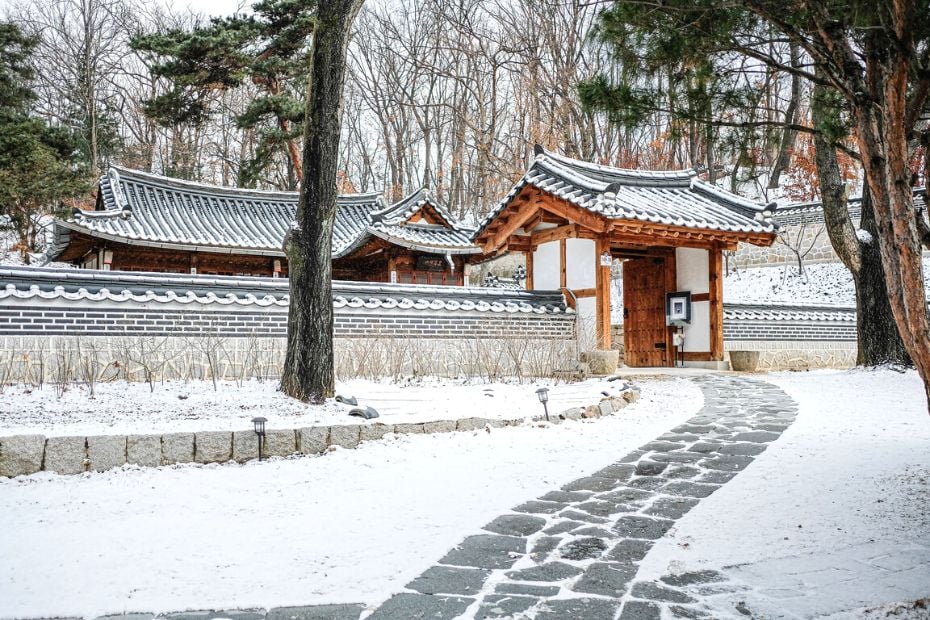
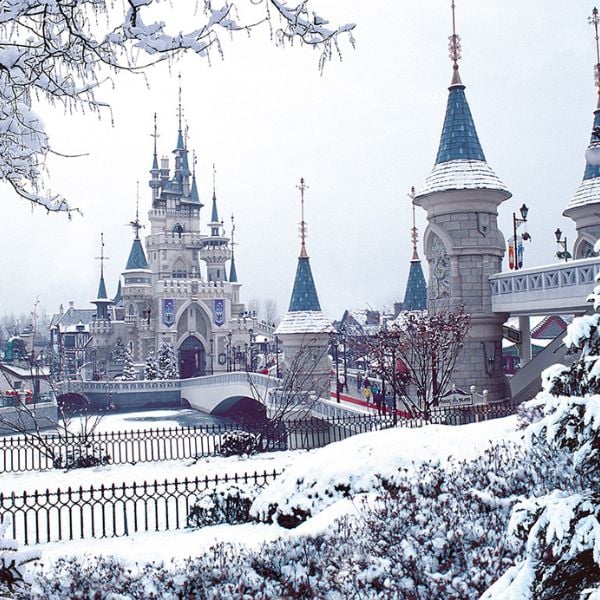
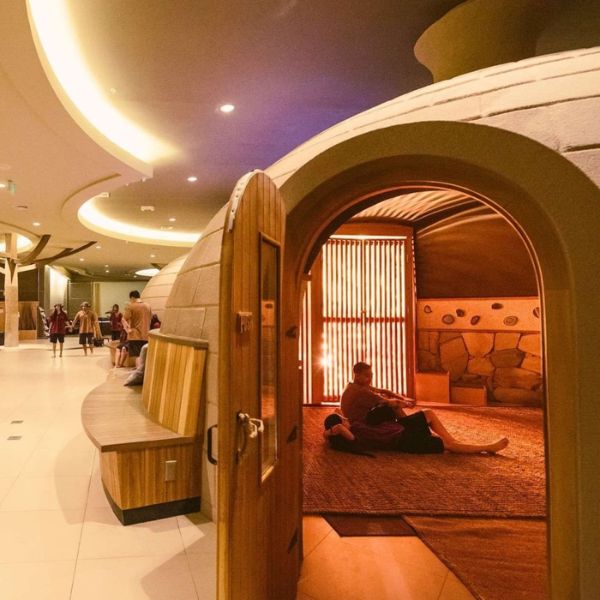

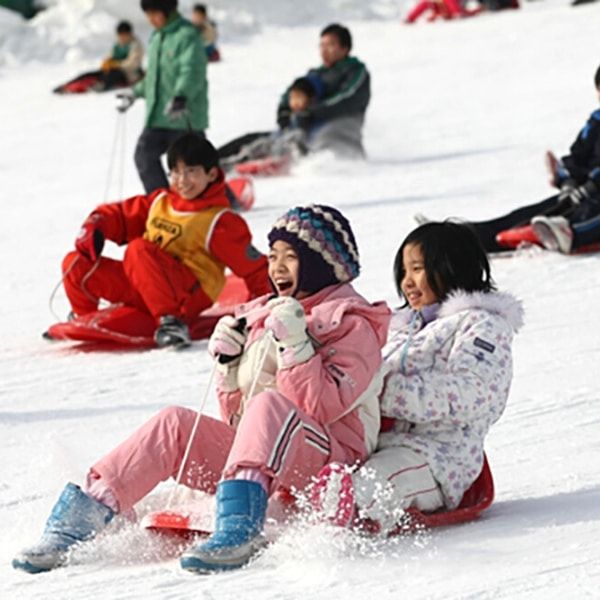
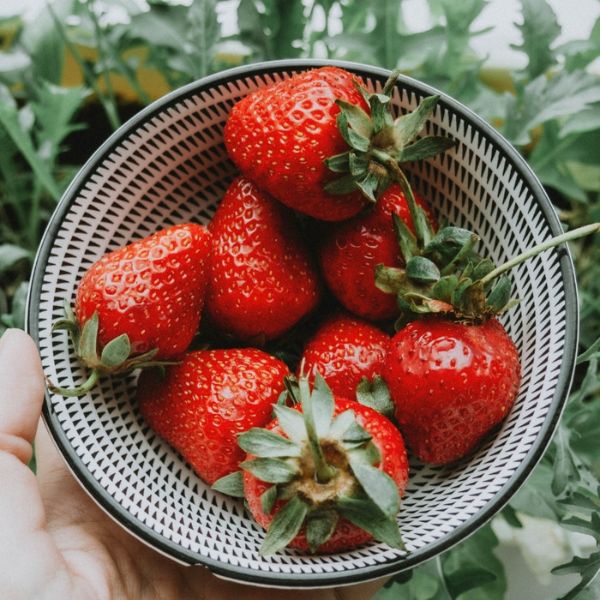

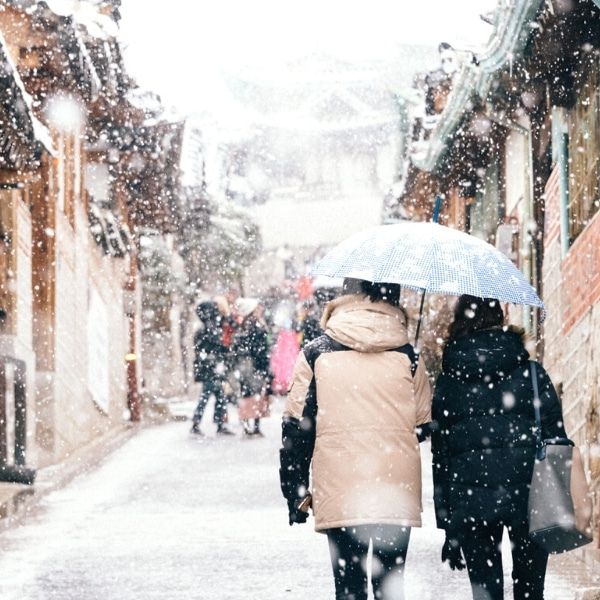
![[4K] Winter in Korea 2022 | Seoul Walking Tour on a blanket of Snow | #snow #seoul](webp/rlmdfrl3g7q-hqdefault.webp)
